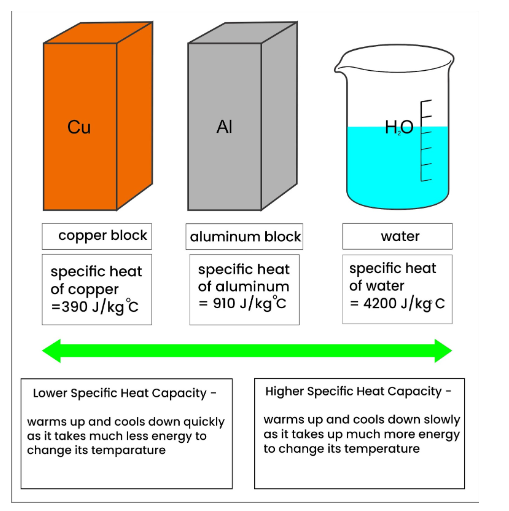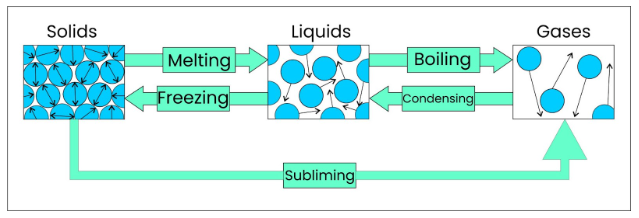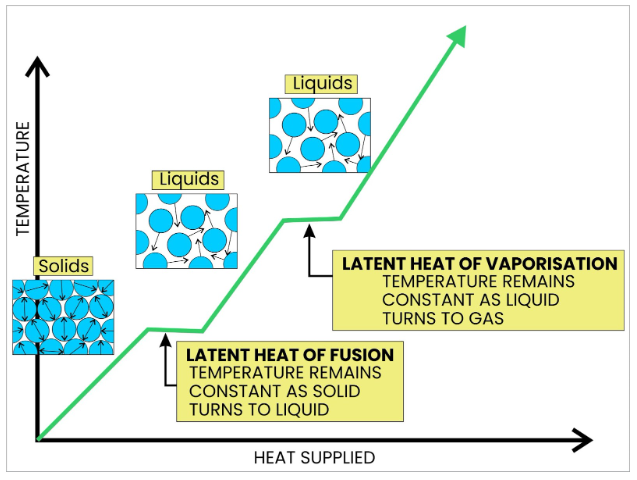Heat Capacity
Defining Specific Heat Capacity
- The specific heat capacity of a substance is the amount of thermal energy required to increase the temperature of 1 kg of that substance by 1 °C.
- This quantity determines the amount of energy needed to alter the temperature of a substance
- Specific heat capacity, denoted by the symbol c, is measured in units of Joules per kilogram per Kelvin (J kg-1 K-1) or Joules per kilogram per Celsius (J kg-1 °C-1), and varies among different substances.
- Specific heat capacities vary among different substances
- Specific heat capacity is mainly used in liquids and solids
- It follows from the definition of specific heat capacity that:
- The more massive the material, the greater the amount of thermal energy required to elevate its temperature
- The higher the change in temperature, the greater the amount of thermal energy required to attain that change
Calculation of Specific Heat Capacity
- The quantity of thermal energy Q required to increase the temperature of a mass m with specific heat capacity c by Δθ is equal to:
ΔQ = mcΔθ
- Where:
- ΔQ represents the change in thermal energy (J)
- m denotes the mass of the substance being heated (kg)
- c represents the specific heat capacity of the substance, measured in either J kg-1K-1 or J kg-1 °C-1
- Δθ refers to the change in temperature (K or °C)

- A substance with low specific heat capacity heats up and cools down rapidly
- A substance with high specific heat capacity heats up and cools down slowly
- The specific heat capacity of various substances determines their suitability for specific purposes, such as selecting the most appropriate material for kitchen appliances
Tabulated values of specific heat capacity for different substances
| Substance | Specific heat capacity / J kg-1K-1 |
| Aluminun | 910 |
| Copper | 390 |
| Lead | 126 |
| Glass | 500 – 680 |
| Water | 4200 |
| Mercury 140 |
- Copper and lead, which are good electrical conductors, also possess excellent thermal conductivity due to their low specific heat capacity
Defining Latent Heat Capacity
- Altering the state of matter necessitates energy
- Some examples of state changes are:
- Melting = solid to liquid
- Evaporation/vaporisation/boiling = liquid to gas
- Sublimation = solid to gas
- Freezing = liquid to solid
- Condensation = gas to liquid

- A change of state in a substance does not involve a temperature change
- The energy input required to bring about this change of state is known as latent heat and is defined as:
Latent heat is the amount of thermal energy required to change the state of 1 kg of a substance without causing a change in temperature
- There are two types of latent heat:
- Specific latent heat of fusion, which applies to the melting process
- Specific latent heat of vaporisation, which applies to the boiling process

- The definition of specific latent heat of fusion is:
The amount of thermal energy needed to convert 1 kg of a solid into a liquid at constant temperature without any change in temperature.
- The specific latent heat of vaporization is used when a liquid is evaporated or boiled and can be defined as:
The amount of thermal energy required to convert 1 kg of liquid to gas at a constant temperature
- When vaporizing a liquid or condensing a gas, the specific latent heat of vaporization is used. It is defined as the thermal energy required to convert 1 kg of liquid to gas with no change in temperature.
Calculating Specific Latent Heat
- The energy required to melt or vaporize a mass of substance, m, with latent heat L, is given by:

Where:
- Q = represents the amount of thermal energy required to change the state (J)
- L = denotes the latent heat of fusion or vaporisation (J kg-1)
- m = represents the mass of the substance undergoing the change of state (kg)
- The latent heat values for water are as follows:
- Specific latent heat of fusion = 330 kJ kg-1
- Specific latent heat of vaporisation = 2.26 MJ kg-1
- It takes approximately seven times more energy to evaporate 1 kg of water compared to melting the equivalent amount of ice to form water
- The explanation for this phenomenon lies in intermolecular forces:
- Melting ice demands energy only to increase the separation between molecules until they can move freely over one another
- Boiling water requires energy to completely break apart the molecules, so there are no more forces of attraction between them. Therefore, this process demands significantly more energy
Heat capacity is the amount of heat energy required to raise the temperature of a substance by one degree Celsius (or Kelvin).
Heat capacity is typically measured in units of Joules per degree Celsius (J/°C) or Joules per Kelvin (J/K).
Specific heat capacity is the amount of heat energy required to raise the temperature of one unit mass of a substance by one degree Celsius (or Kelvin), while molar heat capacity is the amount of heat energy required to raise the temperature of one mole of a substance by one degree Celsius (or Kelvin).
Heat capacity can be calculated using the formula C = Q / ΔT, where C is the heat capacity, Q is the heat energy transferred, and ΔT is the change in temperature.
The heat capacity of a substance depends on its mass and composition, as well as its physical state (i.e., solid, liquid, or gas) and temperature.
Heat capacity is directly proportional to specific heat capacity and mass, and inversely proportional to temperature change.
Heat capacity is a measure of a substance’s ability to store heat energy, while thermal conductivity is a measure of a substance’s ability to transfer heat energy.
The first law of thermodynamics states that the total amount of energy in a closed system is constant, and that energy can be transferred from one form to another. Heat capacity is a fundamental concept in thermodynamics, as it helps to explain how energy is stored and transferred within a system.
Heat capacity has many real-world applications, including in the design of thermal insulation, heating and cooling systems, and the development of new materials for use in high-temperature environments. It is also important in understanding the behavior of materials under different temperatures, which has implications for fields such as materials science, engineering, and geology.





Still got a question? Leave a comment
Leave a comment